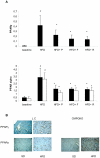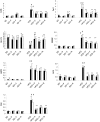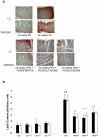Effects of PPARs agonists on cardiac metabolism in littermate and cardiomyocyte-specific PPAR-γ-knockout (CM-PGKO) mice
- PMID: 22563432
- PMCID: PMC3338561
- DOI: 10.1371/journal.pone.0035999
Effects of PPARs agonists on cardiac metabolism in littermate and cardiomyocyte-specific PPAR-γ-knockout (CM-PGKO) mice
Abstract
Understanding the molecular regulatory mechanisms controlling for myocardial lipid metabolism is of critical importance for the development of new therapeutic strategies for heart diseases. The role of PPARγ and thiazolidinediones in regulation of myocardial lipid metabolism is controversial. The aim of our study was to assess the role of PPARγ on myocardial lipid metabolism and function and differentiate local/from systemic actions of PPARs agonists using cardiomyocyte-specific PPARγ -knockout (CM-PGKO) mice. To this aim, the effect of PPARγ, PPARγ/PPARα and PPARα agonists on cardiac function, intra-myocyte lipid accumulation and myocardial expression profile of genes and proteins, affecting lipid oxidation, uptake, synthesis, and storage (CD36, CPT1MIIA, AOX, FAS, SREBP1-c and ADPR) was evaluated in cardiomyocyte-specific PPARγ-knockout (CM-PGKO) and littermate control mice undergoing standard and high fat diet (HFD). At baseline, protein levels and mRNA expression of genes involved in lipid uptake, oxidation, synthesis, and accumulation of CM-PGKO mice were not significantly different from those of their littermate controls. At baseline, no difference in myocardial lipid content was found between CM-PGKO and littermate controls. In standard condition, pioglitazone and rosiglitazone do not affect myocardial metabolism while, fenofibrate treatment significantly increased CD36 and CPT1MIIA gene expression. In both CM-PGKO and control mice submitted to HFD, six weeks of treatment with rosiglitazone, fenofibrate and pioglitazone lowered myocardial lipid accumulation shifting myocardial substrate utilization towards greater contribution of glucose. In conclusion, at baseline, PPARγ does not play a crucial role in regulating cardiac metabolism in mice, probably due to its low myocardial expression. PPARs agonists, indirectly protect myocardium from lipotoxic damage likely reducing fatty acids delivery to the heart through the actions on adipose tissue. Nevertheless a direct non-PPARγ mediated mechanism of PPARγ agonist could not be ruled out.
Conflict of interest statement
Figures





Similar articles
-
Cardiomyocyte-specific knockout and agonist of peroxisome proliferator-activated receptor-gamma both induce cardiac hypertrophy in mice.Circ Res. 2005 Aug 19;97(4):372-9. doi: 10.1161/01.RES.0000179226.34112.6d. Epub 2005 Jul 28. Circ Res. 2005. PMID: 16051889
-
Improved insulin sensitivity after treatment with PPARγ and PPARα ligands is mediated by genetically modulated transcripts.Pharmacogenet Genomics. 2012 Jul;22(7):484-97. doi: 10.1097/FPC.0b013e328352a72e. Pharmacogenet Genomics. 2012. PMID: 22437669 Free PMC article.
-
A peroxisome proliferator-activated receptor alpha/gamma dual agonist with a unique in vitro profile and potent glucose and lipid effects in rodent models of type 2 diabetes and dyslipidemia.Mol Endocrinol. 2005 Jun;19(6):1593-605. doi: 10.1210/me.2005-0015. Epub 2005 Apr 14. Mol Endocrinol. 2005. PMID: 15831517
-
Peroxisome proliferator-activated receptors in vascular biology-molecular mechanisms and clinical implications.Vascul Pharmacol. 2006 Jul;45(1):19-28. doi: 10.1016/j.vph.2005.11.014. Epub 2006 Jun 16. Vascul Pharmacol. 2006. PMID: 16782410 Review.
-
Impact of Peroxisome Proliferator-Activated Receptor Agonists on Myosteatosis in the Context of Metabolic Dysfunction-Associated Steatotic Liver Disease.Discov Med. 2024 Jun;36(185):1139-1153. doi: 10.24976/Discov.Med.202436185.104. Discov Med. 2024. PMID: 38926100 Review.
Cited by
-
Effects of PPAR γ Agonist Pioglitazone on Redox-Sensitive Cellular Signaling in Young Spontaneously Hypertensive Rats.PPAR Res. 2013;2013:541871. doi: 10.1155/2013/541871. Epub 2013 Dec 19. PPAR Res. 2013. PMID: 24454335 Free PMC article.
-
Effect of pioglitazone on the fructose-induced abdominal adipose tissue dysfunction.PPAR Res. 2012;2012:259093. doi: 10.1155/2012/259093. Epub 2012 Oct 2. PPAR Res. 2012. PMID: 23091482 Free PMC article.
-
Post mortem evaluation of inflammation, oxidative stress, and PPARγ activation in a nonhuman primate model of cardiac sympathetic neurodegeneration.PLoS One. 2020 Jan 7;15(1):e0226999. doi: 10.1371/journal.pone.0226999. eCollection 2020. PLoS One. 2020. PMID: 31910209 Free PMC article.
-
Ectopic Overexpression of PPARγ2 in the Heart Determines Differences in Hypertrophic Cardiomyopathy After Treatment With Different Thiazolidinediones in a Mouse Model of Diabetes.Front Pharmacol. 2021 Jul 7;12:683156. doi: 10.3389/fphar.2021.683156. eCollection 2021. Front Pharmacol. 2021. PMID: 34305596 Free PMC article.
-
The Glitazars Paradox: Cardiotoxicity of the Metabolically Beneficial Dual PPARα and PPARγ Activation.J Cardiovasc Pharmacol. 2020 Nov;76(5):514-526. doi: 10.1097/FJC.0000000000000891. J Cardiovasc Pharmacol. 2020. PMID: 33165133 Free PMC article. Review.
References
-
- Borradaile NM, Schaffer JE. Lipo0toxicity in the heart. Curr Hypertens Rep. 2005;7(6):412–7. - PubMed
-
- McGavock JM, Victor RG, Unger RH, Szczepaniak LS. Adiposity of the heart, revisited. Ann Intern Med. 2006;144:517–524. - PubMed
-
- McGavock JM, Lingvay I, Zib I, Tillery T, Salas N, et al. Cardiac steatosis in diabetes mellitus: a 1H-magnetic resonance spectroscopy study. Circulation. 2007;116:1170–1175. - PubMed
MeSH terms
Substances
Grants and funding
LinkOut - more resources
Full Text Sources
Molecular Biology Databases
Research Materials
Miscellaneous

